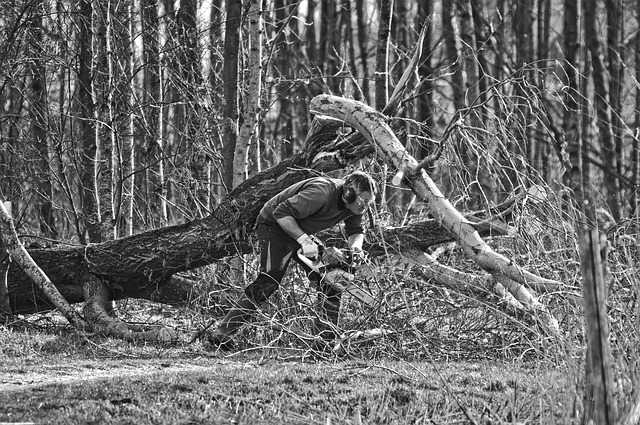Tired of unwanted trees or stubborn stumps causing chaos on your property? Stop searching for "…….
Category: Tree service company Ontario
We\’re a professional tree service company in Ontario dedicated to providing expert tree care for residential and commercial properties. Our certified arborists offer a full range of services, including tree removal, pruning, stump grinding, and emergency tree services. We prioritize safety, efficiency, and the health of your trees, ensuring a beautiful and secure outdoor space. You can trust us for reliable, high-quality workmanship and exceptional customer service.
Tree Service Company Ontario: A Comprehensive Analysis
Introduction
Welcome to an in-depth exploration of the vital sector that is tree service companies in Ontario, Canada. This article aims to dissect and demystify this industry, offering readers a comprehensive understanding of its operations, impact, and future potential. Ontario’s tree service landscape is dynamic and ever-evolving, influenced by environmental considerations, technological advancements, and economic forces. By delving into these aspects, we uncover the intricacies that shape this sector and its role in enhancing urban environments and fostering sustainable practices.
Understanding Tree Service Company Ontario: Definition and Core Components
Definition: A tree service company in Ontario is a specialized business that provides various services related to trees and vegetation within the province. These services encompass tree planting, pruning, removal, landscaping, and environmental consulting.
Core Components:
- Tree Care and Maintenance: This involves regular care practices such as pruning, trimming, and fertilizing to ensure tree health and longevity.
- Tree Removal and Stumping: Companies employ skilled professionals to safely remove trees and grind stumps, a critical service for property maintenance and construction projects.
- Landscaping and Horticulture: Tree service providers often offer landscaping services, including garden design, planting, and maintenance, enhancing outdoor spaces.
- Environmental Services: Some companies specialize in ecological assessments, habitat restoration, and consulting for sustainable practices.
- Equipment and Technology: Modern tree service businesses utilize advanced equipment like climbing gear, chippers, and aerial lift trucks to enhance efficiency and safety.
Historical Context and Significance
The history of tree service companies in Ontario is intertwined with the province’s growth and changing urban landscapes. In the early 20th century, as cities expanded, so did the need for tree planting and maintenance services. Over time, these companies evolved to meet diverse needs, from addressing safety hazards posed by diseased or damaged trees to contributing to sustainable urban development initiatives.
Today, tree service companies play a pivotal role in:
- Enhancing Urban Greenery: They help cities become more livable and aesthetically pleasing by planting and maintaining street trees and urban forests.
- Safety and Property Preservation: Regular tree care prevents accidents and property damage caused by falling branches or diseased trees.
- Environmental Conservation: Many companies contribute to ecological preservation through habitat restoration, reforestation projects, and sustainable practices.
- Economic Growth: The industry supports local economies and employment, particularly in skilled trades.
Global Impact and Trends Shaping Tree Service Companies Ontario
International Influence: While centered in Ontario, the tree service industry is influenced by global trends and best practices. International collaborations and knowledge-sharing initiatives ensure that Canadian companies stay at the forefront of innovation and sustainability.
Key Trends:
- Sustainable Urban Forestry: A growing emphasis on sustainable urban development has led to a demand for environmentally conscious tree care practices, including ecological tree risk assessments and preservation techniques.
- Technological Integration: The adoption of advanced technologies like drones, IoT sensors, and data analytics is optimizing operations, improving safety, and enabling predictive maintenance.
- Specialized Services: Companies are expanding their offerings, catering to niche markets such as heritage tree conservation and urban arboretums.
- Climate Change Adaptation: With changing weather patterns, tree service providers are adapting strategies to address climate-related risks, including pest management and drought tolerance.
Regional Differences: Tree service companies in different Ontario regions face unique challenges due to variations in climate, terrain, and client needs. For example:
| Region | Challenges/Trends |
|—|—|
| Southern Ontario (Cities) | High demand for urban greening, tree conflicts with infrastructure, and managing air pollution. |
| Rural/Farmland Areas | Focus on agricultural tree care, pest management, and forest conservation. |
| Northern Ontario | Dealing with harsher climates, remote access challenges, and preserving native tree species. |
Economic Considerations: Market Dynamics and Investment Patterns
Market Overview: The Ontario tree service market is dynamic, driven by factors such as urban development, government initiatives, and increasing public awareness of environmental issues. According to a 2022 industry report, the province’s tree care and landscaping sector is valued at approximately $1.5 billion, with significant growth projections over the next decade.
Investment Opportunities:
- Public-Private Partnerships: Collaborations between government bodies and private tree service companies drive infrastructure development projects that enhance urban greenery.
- Green Infrastructure Investments: Government incentives and grants encourage businesses to adopt sustainable practices and technologies, fostering innovation.
- Real Estate and Construction Growth: The booming construction sector fuels demand for tree removal, landscaping, and planting services, particularly in residential areas.
- Eco-Tourism: Ontario’s natural beauty attracts eco-conscious tourists, creating opportunities for specialized tree service companies catering to this market.
Economic Impact:
- Job Creation: The industry supports thousands of jobs across the province, offering skilled trade positions and contributing to local economies.
- Revenue Generation: Successful tree service companies generate substantial revenue through a diverse range of services, client contracts, and government contracts.
- Supply Chain Support: They contribute to the broader supply chain by sourcing and supplying plants, equipment, and materials for landscaping and construction projects.
Technological Advancements: Revolutionizing Tree Service Operations
Drone Technology: Drones are transforming tree service operations, offering efficient and safe solutions for tree inspections, pruning, and removal. These remote-controlled aircraft capture high-resolution images and data, enabling precise assessments and targeted interventions.
IoT Sensors and Data Analytics: Internet of Things (IoT) sensors monitor tree health, soil conditions, and weather patterns, providing valuable insights for proactive care. Data analytics platforms predict pest outbreaks, optimize watering schedules, and enhance overall tree management.
Advanced Equipment: Tree service companies invest in state-of-the-art equipment like self-propelled chippers, aerial work platforms, and advanced climbing gear to enhance productivity and worker safety.
Software Solutions: Specialized software applications streamline scheduling, job tracking, and client communication, improving operational efficiency and customer satisfaction.
Policy and Regulation: Governance and Compliance
Ontario’s tree service industry is subject to various policies and regulations that ensure environmental protection, worker safety, and ethical practices:
- Environmental Regulations: The Environmental Protection Act (EPA) governs activities related to trees and vegetation, including permits for certain operations and guidelines for responsible removal.
- Occupational Health and Safety: The Occupational Health and Safety Act (OHSA) sets standards for worker safety, including training requirements, personal protective equipment (PPE), and safe working practices.
- Building Code and Zoning Laws: Local governments enforce building codes and zoning regulations that impact tree removal, landscaping, and construction projects involving trees.
- Forestry and Wildlife Protection: The Forest Conservation Act and related legislation protect forest resources and wildlife habitats, with provisions for tree planting and conservation efforts.
- Licensing and Certification: Tree care professionals must adhere to licensing requirements, ensuring they meet educational and practical standards. Organizations like the International Society of Arboriculture (ISA) offer certifications for specialized arborist work.
Challenges and Criticisms: Overcoming Barriers to Growth
Main Challenges:
- Seasonal Work Fluctuations: The industry experiences peaks and valleys due to seasonal nature, leading to labor shortages during slow periods and potential financial strain on companies.
- Workplace Safety: Tree service work is physically demanding and carries inherent risks. Ensuring worker safety and providing adequate training remains a continuous challenge.
- Environmental Concerns: Balancing tree care with environmental preservation is complex, especially in urban settings where trees compete with infrastructure for space.
- Competition and Market Saturation: As the industry grows, increasing competition can make it challenging for smaller companies to thrive.
Criticisms and Solutions:
- Lack of Public Awareness: Some critics argue that the public lacks understanding of tree care and its benefits. Educational campaigns can raise awareness, fostering a culture of responsible tree stewardship.
- Inadequate Training: To address safety concerns, continuous training programs and industry collaborations with educational institutions are essential to upskill workers.
- Environmental Impact Assessment: Implementing comprehensive pre- and post-project assessments ensures that tree care practices align with ecological goals.
- Collaborative Industry Initiatives: Encouraging companies to share resources, knowledge, and best practices can mitigate market saturation and foster innovation.
Case Studies: Successful Applications and Lessons Learned
Case Study 1: Urban Greening Initiative in Toronto
Toronto’s “Green City” initiative aimed to enhance urban greenery and improve residents’ quality of life. A tree service company partnered with the city to plant 10,000 trees over a 5-year period. The project involved community engagement, educational programs, and targeted planting strategies. Results showed increased property values, improved air quality, and enhanced citizen satisfaction.
Key Takeaways:
- Community involvement is crucial for successful urban greening initiatives.
- Targeted tree planting strategies consider species diversity, microclimate, and community needs.
- Urban greening projects have far-reaching social and economic benefits.
Case Study 2: Heritage Tree Conservation in Niagara Falls
A local tree service company was hired to preserve and restore heritage trees in Niagara Falls’ historic district. This project involved specialized techniques for pruning, disease management, and structural support. The company collaborated with historical societies and urban planners to ensure the trees’ long-term health and aesthetic appeal.
Lessons Learned:
- Heritage tree conservation requires a deep understanding of historical context and collaboration with stakeholders.
- Specialized skills and knowledge are vital for preserving unique and vulnerable tree species.
- Public-private partnerships can lead to successful long-term conservation efforts.
Future Prospects: Emerging Trends and Strategic Considerations
Potential Growth Areas:
- Specialized Services: Niche areas like heritage tree care, urban arboretums, and sustainable landscaping will continue to grow as awareness of unique tree needs expands.
- Climate Change Adaptation: Companies will play a pivotal role in helping Ontario’s natural resources adapt to changing climates through strategic tree planting and conservation.
- Technological Integration: Advanced technologies will become more prevalent, enhancing efficiency, safety, and customer experiences.
Emerging Trends:
- Smart Cities and IoT: Tree service companies can contribute to the development of smart cities by integrating IoT sensors into urban greening initiatives for real-time monitoring and data-driven decision-making.
- Drones for Inspection and Maintenance: Drone technology will continue to evolve, enabling more comprehensive tree inspections and targeted maintenance tasks.
- Eco-Tourism and Outdoor Recreation: As outdoor activities gain popularity, tree service businesses can tap into the eco-tourism market by offering guided nature walks and educational programs.
Strategic Considerations:
- Sustainable Practices: Companies should embrace sustainable business models, incorporating renewable energy sources, eco-friendly equipment, and circular economy principles.
- Data Analytics for Predictive Maintenance: Utilizing data analytics to predict equipment failures and maintenance needs can optimize operational efficiency and reduce downtime.
- Workforce Development: Investing in employee training and apprenticeship programs ensures a skilled workforce capable of addressing future challenges.
- Public-Private Partnerships: Collaborating with local governments, non-profits, and community groups expands opportunities for impactful projects and fosters a culture of shared responsibility.
Conclusion: Shaping Ontario’s Urban Landscapes Together
Tree service companies in Ontario are integral to shaping the province’s urban landscapes, enhancing environmental quality, and fostering sustainable development. From addressing critical tree care issues to contributing to ambitious urban greening initiatives, these businesses play a vital role in community well-being.
As the industry navigates challenges and embraces emerging trends, it is essential to recognize the importance of:
- Continuous Innovation: Adopting new technologies and best practices ensures the industry remains dynamic and responsive to changing needs.
- Environmental Stewardship: Balancing tree care with ecological preservation is a delicate art that requires ongoing education and collaboration.
- Community Engagement: Involving residents in tree-related projects fosters a sense of ownership and encourages responsible tree stewardship.
Ontario’s tree service industry stands at the forefront of urban forest management, offering solutions that enhance beauty, preserve biodiversity, and create resilient communities. As we look to the future, the continued growth and evolution of these companies will shape the province’s natural and built environments for generations to come.
FAQ Section: Addressing Common Queries
Q1: What are the primary responsibilities of a tree service company?
A: Tree service companies in Ontario provide a range of services, including tree planting, pruning, removal, landscaping, environmental consulting, and sometimes even snow removal. They cater to residential, commercial, and municipal clients.
Q2: How do I choose a reputable tree service provider?
A: Look for companies with proper licensing, insurance, and positive customer reviews. Check their experience in your specific needs (e.g., heritage trees or urban greening). Ask for references and ensure they follow industry best practices and safety standards.
Q3: Are there any regulations governing tree removal?
A: Yes, the Environmental Protection Act and local by-laws typically require permits for certain types of tree removal, especially in protected areas or near heritage structures. Tree service companies should be familiar with these regulations to ensure compliance.
Q4: How can I reduce the impact of seasonal fluctuations on my business?
A: Diversify your service offerings to cover a broader range of year-round projects. Develop strategic partnerships to secure steady work during slower periods and consider offering maintenance packages to retain clients.
Q5: What are some eco-friendly practices tree service companies can adopt?
A: Companies can embrace sustainable practices by using organic pest control methods, implementing water conservation strategies, investing in renewable energy, adopting circular economy principles for equipment and material reuse, and promoting native tree species.
Save Money & Enhance Your Property with Our Top Arborist Solutions
Tired of high prices and subpar tree care? Our local tree care company offers certified arborists pr…….
Expert Tree Care: Save Money with Our Top-Rated Arborists – Free Consultation!
Hiring a tree service company is not just about maintaining the aesthetics of your property; it'…….
24/7 Stump Removal: Save Money, Fast & Free Quote Today!
Tired of unsightly stumps taking over your yard and costing you dearly? Our professional 24/7 stump…….
Revolutionize Your Yard: Safe, Efficient Tree Care – Save with Our Expert Service!
Looking for a hassle-free way to keep your property safe and beautiful? Choosing our reputable tree…….
Free Storm Damage Tree Removal: Quick, Safe, and Affordable Near You!
Tired of the costly and dangerous aftermath of storm damage? Say goodbye to fallen trees and branche…….
Stump Grinding Pros: Stumps R Us for Healthy Trees & More Space
Tired of unsightly stumps taking over your garden? Stumps R Us offers a fast, efficient, and budget-…….
Revolutionize Your Yard: Expert Stump Grinding, Save Money Today!
Elevate your property with a professional tree service company. Our experts offer seamless stump gri…….
Clear Land Efficiently, Save Money – Expert Stump Removal Today!
Don't let unsightly stumps become a costly headache! Our professional stump removal service is…….
Free Assessments, Healthy Trees: Top Arborist Care at Unbeatable Prices
Protect your investment and enhance your outdoor space with our free tree health assessments from ce…….










